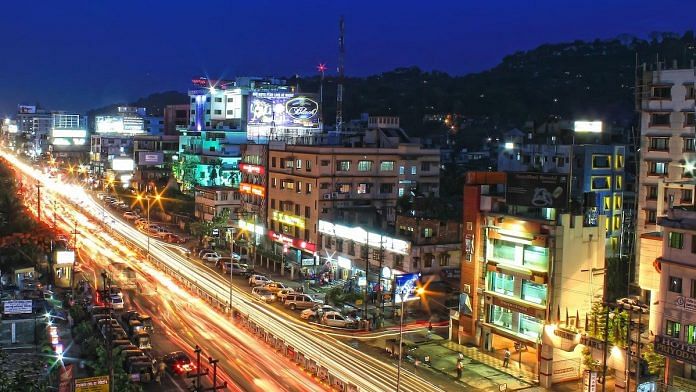When talk turned to acting upon India’s Act East Policy, to seek better relations with South-East Asia using the conduit of north-eastern India to integrate the Asian highway system for moving goods and people; and opening up of road, rail and waterway links between India and Bangladesh to enable the movement of goods, services and people between that region of India and the ‘Mainland’, tempers ran high in the audience. Even talk of ambitious projects like a localised version of the Delhi-Mumbai Industrial Corridor, sometimes dramatically billed as the ‘Seven Sisters Corridor’—surprisingly leaving Sikkim out of the equation—and the Asian Highway project that mostly remains a paper-route, if you will, in this region, was distilled to one major concern. Would it all lead to the greater ‘movement’—migration—of people primarily from Bangladesh and elsewhere in India, and, to a lesser extent from Myanmar, into North-East India? If so, forget it.
There was complete disengagement with the reasons behind migration, let alone the continual inevitability of it. Livelihood needs will push it. For instance, without rapid and sustained socioeconomic development of Bangladesh, both India and Bangladesh will be powerless to stem it. Importation of religious belief, by virtue of Bangladesh’s largely Islamic construct, may be a corollary, but religion, whether out of fear or favour, has for long stopped being the motive for migration. Even the exercise to fence India’s 4,000 km-plus border with Bangladesh, some of it riverine, will hardly be a barrier to what the future can hold.
I had the opportunity to speculate about this future in a position paper for the Kesroli Group, a think tank of top professionals, entrepreneurs and technocrats of Indian origin—some of whom subsequently joined the central government after the BJP-led coalition assumed power in 2014—for a presentation to senior policymakers and CEOs. The matrices of China and India, Bangladesh and India, and the violent ethno-political dynamics of North-East India make for an incendiary historical and geopolitical mix even without adding inputs by nature, I posited in the paper and to that audience during a weekend retreat at the sprawling campus of Infosys Limited in Mysuru.
Also read: Northeast needs to boost its economy. Even Assam has failed to participate in India’s growth
This was in 2009. There was still relative amity and exchange in India among right-of-centre, centrist and left-of-centre views that together sought solutions instead of unilateral, often-unmitigable actions. My task was to present logical scenarios of the medium- and long-term future; offer a ‘war-gaming’ approach with the express purpose to offer solutions, mitigate ‘worst-case’ to ‘manageable-case’.
In retrospect my take probably cut a bit too close to the bone. But I would stand by its alarm bells—and so has a referee of that paper who in 2014 became a minister with the BJP-led central government—as long as there is no evidence to the contrary. The combination of China and India, Bangladesh and India, and the ethno-political dynamics of the far-eastern arc of India make for an incendiary historical and geopolitical mix even without adding ‘natural’ causes—caused by nature and man alike. Altogether it presented the most complex, interlinked, inter-dependent landscape.
What would happen if Bangladesh were to suffer a series of cataclysmic storms and inundation of its coastline on account of global warming? Unlike the relatively gentler inward migration forced by a similar inundation of the Indian coastline along the Bay of Bengal, the population pressure of Bangladesh, expected to be more acute than
India’s for several decades into the 21st century, would lead to its citizens literally forcing their way to every other point of the compass to escape the country’s vulnerable south.
India would be powerless to stem this migration—another kind of flood. In this migration, livelihood needs—the brutal matter of survival—would trump any push of religion. There might even be the somewhat ironical instance of Bengali Muslim migrants to Bengali-majority and Muslim-majority districts of India bordering Bangladesh—Goalpara, Dhubri, Karimganj and Hailakandi in Assam, for instance, and nearly the entire strip along West Bengal’s border—having to compete with ever newer arrivals. In any case, such a future would turn migration into territorial usurpation, driven by the influx from present-day Bangladesh.
India’s east and North-East could change in a way that would make even the effects of the Citizenship Act and the National Register of Citizens look like tame fireworks.
Also read: Nagaland massacre shows AFSPA is a deadly addiction. Does Modi govt have the courage to kick it?
Kolkata could implode. If this were to happen, the Government of India of the time would be compelled to deploy military along this area. This would be further west from the existing border fencing along India’s border with Bangladesh in the territory of West Bengal. Such an eastern Line of Control—a cousin of the Line of Control along India’s western border with Pakistan—could form the de facto eastern boundary of India, running north to south roughly from Barauni-Katihar in present-day Bihar and run continuously south along the eastern borders of present-day Bihar, Jharkhand and Odisha and the mining rich areas west of present-day Bardhaman in West Bengal. This would be additional impetus to secure India’s key mining and industrial belts against the influx. Economics as much as security would surely drive this cauterising.
India’s urban spaces would be particularly vulnerable to strife, as it would need to absorb extra millions driven by the force of the migratory explosion. This migratory traffic would also place severe stress on present-day agrarian and rural spaces. Further, driven by the needs of the burgeoning population, there could be a continuing push to extend habitation, farming and industry deeper into ‘breathing rooms’: forested areas.
 Excerpted with the permission of Simon & Schuster India from The Eastern Gate: War and Peace in Nagaland, Manipur and India’s Far East by Sudeep Chakravarti HB Rs. 899, 432pp
Excerpted with the permission of Simon & Schuster India from The Eastern Gate: War and Peace in Nagaland, Manipur and India’s Far East by Sudeep Chakravarti HB Rs. 899, 432pp



